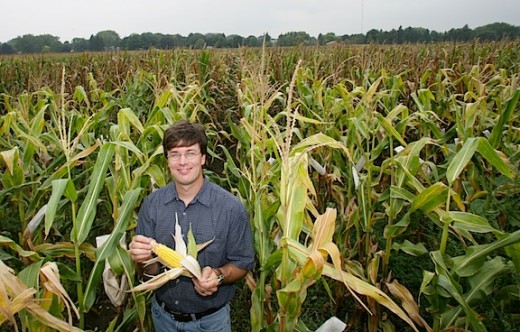
Geneticists are working to improve corn’s ability to provide food while minimizing environmental harm. But it’s becoming increasingly clear that genetics is not the only game in town. As we learn more and more about what happens within cell nuclei, scientists are recognizing that inherited characteristics are shaped not only by DNA but also by molecules that modify gene activity in a way that’s also passed from one generation to the next.
Known as epigenetic (“beyond genetic”) factors, these molecules are of growing interest to the geneticists who work to improve crop traits. They’re also the subjects of study for plant biology associate professor Nathan Springer. Now, with the help of a four-year, $3.4 million grant from the National Science Foundation, Springer and colleagues at three other institutions are going to take a deep dive into maize epigenetics in hopes of providing information the crop improvement industry can use to breed more productive, less environmentally impactful plants.
Over the past decade, Springer has laid substantial groundwork by describing the variability of epigenetic traits among various maize lines. The new research, which involves experts at the University of California, Berkeley, the University of Texas, and Hamline University as well as the University of Minnesota, will build on that research with four goals in mind.
First, the researchers plan to paint a clearer picture of the extent to which epigenetics is at play in corn by looking at variability in epigenetics in maize and its ancestor, teosinte. In particular, the team is interested in looking at the addition of methyl molecules to DNA – thought to be a primary epigenetic mechanism – to identify the extent to which it really is a heritable trait that should be of concern to plant breeders.
The team members also will look at what causes epigenetic differences to arise, and to get a sense for how stable they are across generations and in the face of environmental stress. In addition, they hope to connect epigenetic features at the molecular level to specific plant traits. In the past, Springer says, epigenetics research has started by looking at characteristics and trying to understand what epigenetic factors might be at play. Springer aims to take the opposite tack. “Instead of working from, one plant is tall and one is short,” he says, “we’re working from, ‘Let’s find the epigenetic difference; find out what those do to phenotypes.’” Finally the team will develop a maize epigenetics database for other researchers to tap.
Springer anticipates the research will apply broadly to enhance understanding of epigenetics as a factor in the development and function of organisms or all sorts. But he also notes the research will find quite practical application related to feeding a growing human population by helping target crop improvement efforts to where they matter most.
“One of the main things I think we’re going to learn is how valuable is knowing the epigenome for predicting phenotype,” he says. “People have made the argument that the reason scientists are limited in predicting the best genotypes is that [maize traits are affected by] epigenotype. The question we’re asking is, ‘Is that really true?’”
If the answer is yes, Springer says, seed companies would do well to pay attention to epigenetic factors in crop improvement programs. But if the epigenetic input is minimal, it might make sense for them to focus their efforts on genetic improvement instead. And because epigenomics operates in other food crops as well, the lessons learned here are likely to benefit production of rice, wheat and other crop species as well.
“The big question is, ‘What is the added value of providing the epigenome in addition to the genome?’” Springer says. “The answer to that question in maize will likely be similar for rice, wheat, just about any of the big crop species. It allows you to do a cost-benefit analysis.” – Mary Hoff